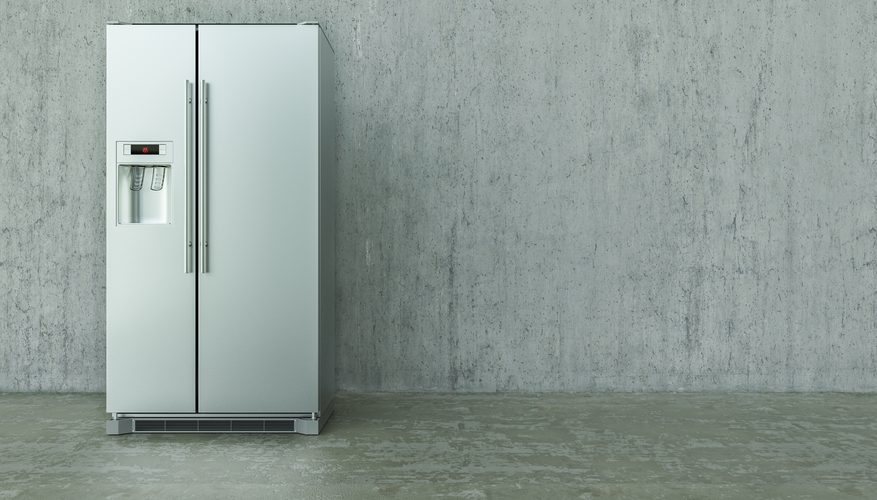HOW TO INSTALL A NEW REFRIGERATOR
The huge cardboard boxes that the fridge was shipped in is easier to open outside, where you have room. Remove the cardboard box and other packing parts and set them aside. Don't throw them out until the refrigerator has been up and running for a few days, though, in case you need to return it for replacement or repair
.

Inside the refrigerator, remove all of the shelves, drawers and other components and set them aside so they don't get damaged while installing. However, leave the plastic covering on the refrigerator doors in place: this can protect them from damage as you move them.
Move the refrigerator
To move a refrigerator, the easiest way is to use a dolly or hand truck, tilting the refrigerator on one side so the weight is balanced on one side. Never put a refrigerator on its side or upside down: this can weaken or damage the cooling mechanism inside. If you need to carry it up stairs, keep it as upright as possible and move carefully to avoid knocking it.
Larger refrigerators are especially difficult to move, because they often won't fit through the doorways in your house. There is a hidden trick here, though: all refrigerators are designed to have removable doors. The doors are held in place by bolts at the top and bottom, and can be removed by undoing them. Check the manual for details on this, though: some may require that you remove the bolts in a particular order, or remove other parts (such as water feeder lines) first.
Once the door (or doors) are removed, the refrigerator will be much thinner and easier to move into the kitchen. Once it is installed, you can replace the doors by reversing the sequence and you are good to go.
Mind the gap
You, of course, measured the space that the refrigerator and bought an appropriately sized one. But it never hurts to double-check: Before you move the refrigerator inside, measure the spot that it is going into, taking note of the depth, height and width. Then compare this with the measurements of the refrigerator itself and air gap that the manufacturer recommends. You'll find this in the manual that came with the refrigerator This gap allows air to circulate, carrying away the heat that the refrigerator is removing from the food inside. The size of the required gap varies with different models and types of refrigerators, so make sure you check this and have the space you need.
Modern refrigerators don't have the exposed coils that you might remember on the back of your grandparents' fridge. These were one of the main ways that refrigerators were damaged: crack these fragile pipes, and the coolant would escape. Instead, the coils on modern refrigerators are mounted inside the body, against a metal plate on the back of the fridge. You still need to make sure that this plate has the space to radiate the heat away, though: most fridges will require a space of 2 inches or so to provide the proper air currents. If you are interested in how refrigerators work, read my article on the cool physics of refrigerators.
You should never skimp on the air gap: your refrigerator might still work if you do, but it won't run as efficiently as it could, and you are shortening the life of the refrigerator by making it work harder to remove the heat.
You should also double-check on the space required for the door and hinge: some refrigerators will require a lot of clearance to allow you to open the door properly. Again, the details of this should be in the installation guide.
Slide it in
Once you are happy with the space that the refrigerator will go into, put it in front of the space, but with enough of a gap that you can get behind it. Sweep out the space to get rid of dust and dirt, then connect the power and water, making sure that the cables for both are against the wall so they won't get caught as the refrigerator slides in.
Push the refrigerator in slowly, checking that it is not getting caught on any cables or flooring. Many fridges come with wheels on the back to make this easier: lift the front up gently so the front legs are off the ground and push backward gently.
Once it is in place, check the air gap on each side to make sure it is as wide as the manufacturers recommend. If not, pull it out, move it in the required direction and slide it in again.
Now you can replace the doors if required. These will need leveling to make sure that they are flat against the front of the refrigerator and form a tight seal. The method of doing this varies but usually involves adjusting a screw at the bottom of the door to level it. You should also make sure the refrigerator itself is level, as they work most efficiently this way. See this article for details on how to do this
Next, install the shelves and trays, close the doors and let the refrigerator start working. Don't expect the fridge to become cold immediately: some refrigerators may require a few hours for the cooling system to settle down and start working after being bounced about during shipping. However, if you aren't detecting any drop in temperature within 24 hours, call the retailer or manufacturer and ask for assistance.
You got a 1.26% upvote from @upmewhale courtesy of @mczahid!
Earn 100% earning payout by delegating SP to @upmewhale. Visit http://www.upmewhale.com for details!
really thanks upmewhale